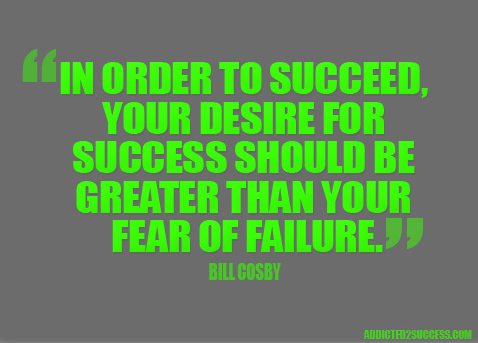Success Advice
10 High Performance Habits That Lead To Success
You can’t expect to get the results high performers do, if you don’t adopt the habits high performers have. When you look at the successful people of the world, don’t neglect to consider the hours of work, the multiple failures, and the daily sacrifices they made to get there. If you are serious about taking your performance to the next level you’ve got to leave the ways of mediocrity behind to develop a new and improved you.
Here are 10 high performance habits that may require you to go against the grain but will aid you in reaching success like the pros:
1. Win the Morning
While the world sleeps, the high performer works. Could you imagine if you woke up on purpose, with purpose every day? How can you expect to achieve excellence when the first decision you make on a daily basis is to procrastinate the day by hitting the snooze button?
Win the morning by waking up earlier than you normally do to get a workout in, feed your mind with good books, and fuel your body with a good breakfast—all before the rest of the world is deciding whether to get up or not. Win the morning.
2. Do Hard Things
We are surrounded by people who want the fastest and easiest path to success, but not you—not anymore. Rather than run from the challenge that is keeping you from doing what you want, stare it in the face; learn about it; and embrace it.
“The road to greatness is easy”, said “no one ever”.
Doing hard things will teach you lessons you wouldn’t learn otherwise, and will make you stronger than you thought possible.
You can do hard things.
3. Embrace feedback
The average person hates to be told what they are doing wrong or what they can do better. Learning to accept feedback is not easy, but once you decide to seek it out and act on ways you can improve, you will dramatically improve your progress.
Embracing feedback doesn’t mean to do what everyone tells you; identify key mentors or coaches who are great at what they do and more importantly, who care about your future, then allow them to take you places you wouldn’t have gone otherwise.
4. Learn from Failure
No one likes to fail, lose, or mess up; but high performers use adversity to learn lessons, and refuse to allow them to disable them emotionally. When you fail, identify what you did well, what you can do better, and what you are going to do about it right now.
5. Choose your attitude
One of the most important decisions you make every day is the attitude you are going to have when you walk out your door. Don’t take your attitude for granted or it will get the best of you.
6. Do one more
As an athlete, you can do 10 reps in the weight room, or you can do 11. As a sales rep you can choose to make 15 calls or choose to do 16. One of the best ways to build mental strength is to do something you might not want to do, but you know will help you.
Do one more—because the average person won’t.
7. Have a purpose
The clearer you can see your target, the more likely you are to hit it. High performers don’t do things “just because”, as mentioned earlier, they do things on purpose, with purpose. When you know why you do what you do, you’ll have more power to do it.
8. Recommit every single day
One reason the average person doesn’t achieve their goals is because life catches up to them and they allow the things that they have to do blind them from the things they want to do. Every day, recommit to the things that matter most.
You empower yourself when your priorities are in line.
9. Be patient
Success is made in a slow-cooker, not a microwave. High performers understand that overnight success comes after years of hard work. Be patient with yourself, keep your eyes on the prize and focus on the process, the results will take care of themselves.
10. Fear no one
Refuse to allow people to intimidate you. You don’t need anyone’s permission to do something great. Putting others on a pedestal because of their talent, experience, and or accolades makes you susceptible to beating up on yourself because you feel that you’re not as good as they are. Anyone can be beat, including you; so respect your competition but refuse to fear them—who knows, they may fear you.
Did You Know
How Skilled Migrants Are Building Successful Careers After Moving Countries
Behind every successful skilled migrant career is a mix of resilience, strategy, and navigating systems built for locals.

Moving to a new country for work is exciting, but it can also be unnerving. Skilled migrants leave behind familiar systems, networks, and support to pursue better job opportunities and a better future for their families. (more…)
Life
10 Research-Backed Steps to Create Real Change This New Year
This New Year could finally be the one where you break old patterns and create real, lasting change.

Every New Year, we make plans and set goals, but often repeat old patterns. (more…)
Change Your Mindset
The Silent Skill That Makes People Respect You Instantly
What truly earns respect and why most people go about it the wrong way

Everybody craves respect but not everyone earns it. Some people believe that a title, years of experience, or a position of authority automatically entitles them to respect. (more…)
Entrepreneurs
The Essential Skills Every Entrepreneur Needs In 2026
Success in the digital age isn’t about luck. It’s about mastering the skills that separate dreamers from doers.

When I was 22 years old, I started my first side hustle as a ghostwriter. (more…)
-

 Business4 weeks ago
Business4 weeks agoWhy Your E-Commerce Fulfilment Is Probably Broken (And How to Fix It)
-

 Shift Your Mindset3 weeks ago
Shift Your Mindset3 weeks ago11 E’s That Define Every Great Leader And Why Most People Miss Them
-

 Did You Know3 weeks ago
Did You Know3 weeks agoThe Success Patterns You Inherited (And Didn’t Notice)
-

 Business3 weeks ago
Business3 weeks agoThe Hidden Money Pit in Your Operations (and How to Use It)
-

 Entrepreneurs2 weeks ago
Entrepreneurs2 weeks agoThe Essential Skills Every Entrepreneur Needs In 2026
-

 Change Your Mindset2 weeks ago
Change Your Mindset2 weeks agoHow to Turn Your Mind Into Your Greatest Asset (Instead of Your Enemy)
-

 Change Your Mindset1 week ago
Change Your Mindset1 week agoThe Silent Skill That Makes People Respect You Instantly
-

 Life6 days ago
Life6 days ago10 Research-Backed Steps to Create Real Change This New Year




























63 Comments